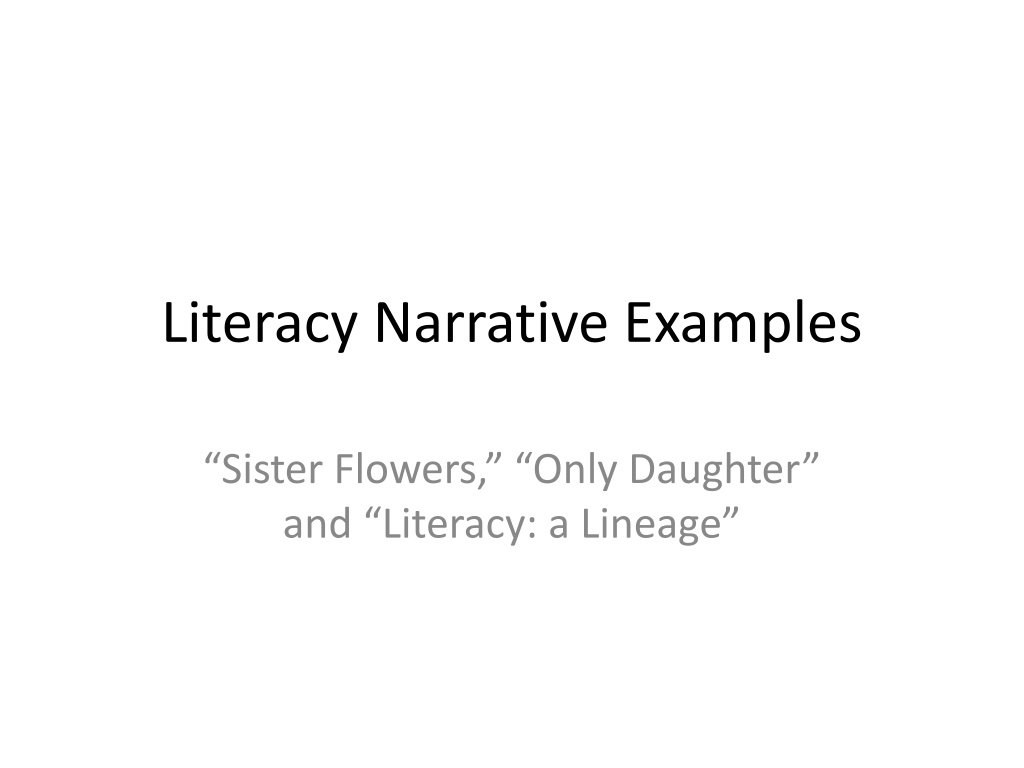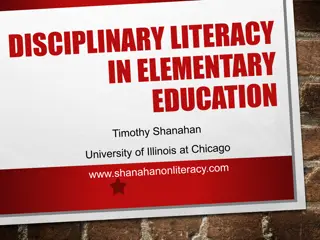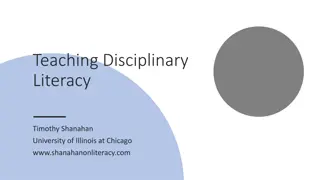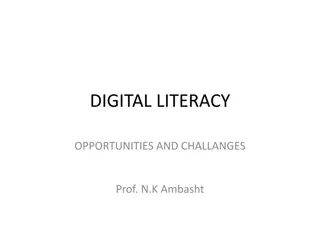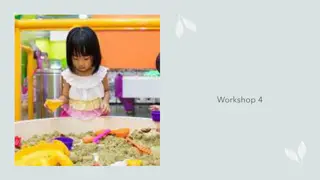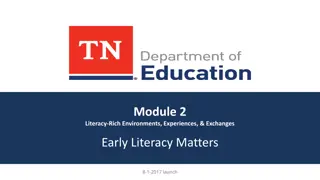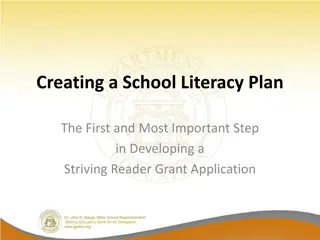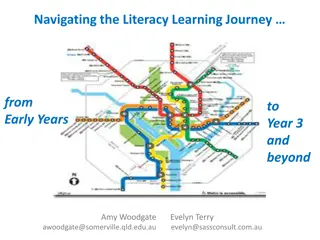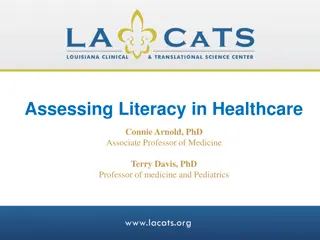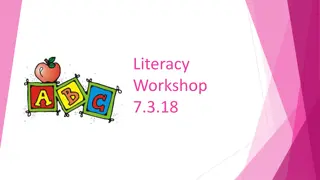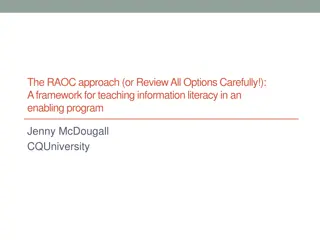Exploring Literacy Narratives Through Examples and Analysis
Delve into literacy narratives through examples like "Sister Flowers" and "Only Daughter." Discover how familial influences shape attitudes towards reading and writing, influencing personal development as a reader and writer. Prepare for discussions on key themes, character dynamics, and narrative styles present in the texts.
Download Presentation

Please find below an Image/Link to download the presentation.
The content on the website is provided AS IS for your information and personal use only. It may not be sold, licensed, or shared on other websites without obtaining consent from the author. Download presentation by click this link. If you encounter any issues during the download, it is possible that the publisher has removed the file from their server.
E N D
Presentation Transcript
Literacy Narrative Examples Sister Flowers, Only Daughter and Literacy: a Lineage
Quickwrite #3 In our readings for today, all of the writers were influenced by the ideas about reading, writing, and education the adults in their lives had. For example, in Only Daughter, Sandra Cisneros father s ideas the importance of education were very important to her development as a writer. What attitudes about reading and writing did the adults in your family have when you were a child? How did those attitudes shape your development as a reader/writer?
Preparing to discuss Sister Flowers If you have not done so already, take notes on what you read, either on the essay or on another sheet of paper. Highlight or make a note of important passages and main points. (Make a note of paragraph numbers in your notes so you can find these quotes easily.) Make connections between various parts. Ask questions of the text, make predictions, connect to your own experience. Be ready to share your annotations with a partner.
Questions for Sister Flowers What is the significance of "Sister Flowers"? (What is the point of the narrative?) What are some particularly good pieces of description in this piece? Look for places that she uses specific detail to allow the reader to imagine the scene or people she describes. How does she create tension? What contrasts does she create? (Tension here could mean suspense, but it could also mean places that make the reader a little uncomfortable, things that aren't as they should be, ideas and people that are in conflict with each other.)
Questions for Sister Flowers Who is the narrator of the story? Why is it significant that her younger self does not have much dialogue? How old is the narrator at the time of the events described in Sister Flowers ? In what ways does the author show her youth? Where are some of the particular places where Maya Angelou talks about her relationship with words?
Points to Notice About Only Daughter : Sandra Cisneros starts the story with an event that happened recently, then goes backwards in time to when she was a child. Why do you think she does this? Throughout the literacy narrative, she gives her audience a sense of when events happened in relationship to the other events she has already described. This is something you need to do in your own literacy narrative.
Questions About the Reading: What do you think the author is saying about how our upbringings/cultural/class situations in life shape us? How do you think they shape us? What is it that changes over the course of this narrative? How does Cisneros help her readers to understand the significance of this change? What are specific details Cisneros uses to make her narrative vivid and unique to her?
I am a. Fill in this sentence for yourself. "I am a/an __________ . That explains everything." Remember, you can fill in the sentence with one or two words, or with several phrases, like the author of our reading did.
Comparison of Only Daughter and Literacy: A Lineage 1. In both of these essays, the authors write about their relationships with their fathers. Compare them, and consider how each author describes her father and his effect on her grown as a writer/reader. 2. What other similarities/differences do you see between these two essays?
Introducing your narrative Cisneros uses an interesting quote to introduce her narrative and grab the reader s attention. How does Maya Angelou introduce Sister Flowers ? How does Melanie Luken introduce Literacy: A Lineage ? How might you introduce your narrative? - A quote or line of dialogue that will interest your reader - A colorful, unique event that relates to your main point - Useful background information
Writing Reflectively When we reflect, we don't simply tell what happened. We also think about Why it happened What patterns/attitudes influenced events How we felt about what happened How what happened continued to affect us How what happened fits into the "big picture" of human experience And, of course, what we learned/realized
Tips for writing reflectively: Be honest. Don't worry about "revealing too much." This class is a safe place to reflect and express yourself. Push yourself out of your comfort zone. Good writing tends to make lots of people (including the author) uncomfortable. Work through your discomfort and see what you end up with.
Noticing Reflective Writing Look back over the literacy narratives we have read so far ( Sister Flowers, Only Daughter, and Literacy: A Lineage ). Find a place where one of the authors reflects on her experience. What does this reflection add to the essay?
Writing Reflectively in Your Literacy Narrative Choose one or two of the events you're going to talk about in your literacy narrative. Write for five minutes about: Why these events in your narrative happened. You might want to consider social conditions cultural issues choices you/other people made other patterns of events
Writing Reflectively in Your Literacy Narrative Write for five minutes about how you feel about these events/reasons. I'm not going to collect these, so don't censor yourself. Please take this seriously, though. You may find out that you have something you can go through and edit later. Write through your discomfort.
Making sentences more specific: Highlight AT LEAST five sentences in your draft or any of your brainstorming that you think could be improved by adding detail or sensory imagery. (Hint: sentences with "things," "stuff" or other non-specific words are prime candidates for this.) Give each of them a number. (Highlight as many as you wish.) Example: When I was in grade school, there was this thing that got sent home, and I ordered books from it. What questions do you have about this sentence? What could I do as an author to make it more interesting?
Making sentences more specific: Now that we have rewritten our example sentence as a class, do the same thing for your own sentences that you highlighted. Rewrite every single one of them. When you put them back into your essay, erase the old, less detailed sentence.
Adding Dialogue to Your Narrative Dialogue pointers: Dialogue can enhance your reader's feeling of actually "being there." Words being spoken are always encased in "quote marks." New speakers always get a new indented paragraph.
Example dialogue: "Did you do your history reading?" my mother asked. "Not yet," I said. She told me, "You should do it right now before you watch any TV." "But my favorite show is about to start," I protested, and I don't have time to finish before then." "That's too bad," she said.
Practice Dialogue for Literacy Narrative Dialogue tags (such as 'Jim said,' or 'yelled Annie') are useful, but not always necessary if two characters are going back and forth and it is very obvious who is speaking. You can always show it to another writer in the class for opinions about whether or not your dialogue is clear. Remember, dialogue can be mixed in with detail. Find a place in your narrative where you describe an event that could be better told through dialogue. If you are the only person in your narrative, think of a conversation about writing or reading that you have had and use it for this exercise. You can put your dialogue in if you decide it fits, or you may decide not to use it.
Using Details to Communicate Mood Previously, we have talked about sensory detail and how including sensory details can improve your descriptions and interest your readers. Sensory details can also help you to communicate mood by creating a dominant impression. For instance, if a student was writing about how writing in school always made her feel cramped and confined, she might also choose to write about tight shoes, crammed classrooms, and stifling air in the summer. These details serve two functions: they set the scene, AND they reinforce your point.
Dominant Impression Practice: This Room What words would you use to describe this room if you wanted to create the following different dominant impressions: Worry/anxiety Boredom Calm Optimistic excitement
Making Your Own Dominant Impression Your task: Choose a place, person, or event that appears in your literacy narrative, decide on a dominant impression, and write or heavily revise one paragraph using words and images that support that impression. Be sure to save your work if you are working on a computer. Decide what your point is, and highlight/circle some of place where you need to add details that might help you to reinforce that point. (What you're doing here is making a choice about mood. It's one of the many choices that writers make what mood should the narrative have?)
Expectations for Peer Review: Upload a complete draft to turnitin. It doesn t have to meet the required page length yet, but it needs to at least try to tell the whole story. Upload your draft to turnitin on time. Read and comment on the essays assigned to you before class begins on the day of peer review. Comments should be thoughtful and specific. Come to class with questions for your peer group about how to improve your essay. Come to class with the most recent copy of your draft printed out. After peer review, you may have time to put your group s suggestions to work in your essay.
